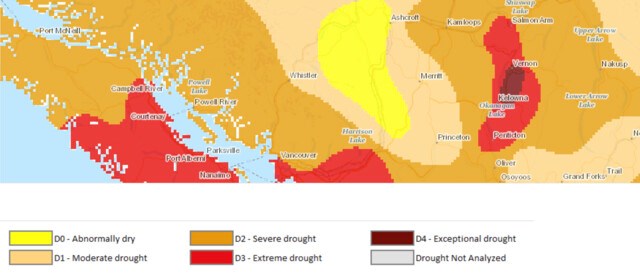Agriculture Canada says the Okanagan recorded its driest soil moisture levels on record last month as drought conditions worsened.
The federal agency declared “exceptional drought” conditions — the highest on the federal scale — in Kelowna and Vernon. “Exceptional drought” conditions are typically seen just once every 50 years, but were last observed in the Okanagan in fall 2021.
“In the Okanagan River Basin, most stations reported exceptionally low precipitation, with Penticton and Vernon receiving only 5.1% and 2.1% of their normal precipitation this month, respectively,” said Ag Canada’s monthly drought report, looking back at August.
“The area also faced other challenges including both the driest soil moisture levels on record and a major wildfire near Kelowna.”
Throughout the Thompson-Okanagan, Cariboo and Lower Mainland weather was about four degrees above normal and rainfall levels were only 40 to 60% of their normal monthly precipitation.
“The ongoing precipitation deficits and high temperatures led to increased irrigation demands, earlier than normal berry harvests and evacuation orders due to wildfires,” said Agriculture Canada.
“Water restrictions were also put in place in some areas to address low streamflows and to protect fish populations.”
The B.C. government’s own drought monitor has had the entire Thompson-Okanagan at the highest level of drought since Aug. 17.
Farmers in the Westwold area have been clashing with the government over water restrictions imposed in the area on forage crops.
The provincial government has planned a news conference on the drought and wildfire situation for Wednesday.

Drought conditions as of Aug. 31, 2023. | Agriculture Canada




